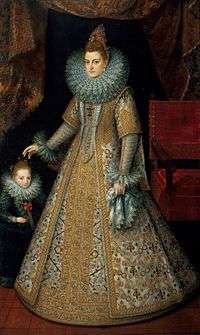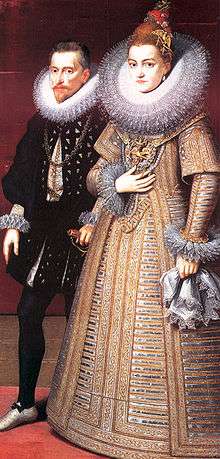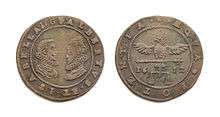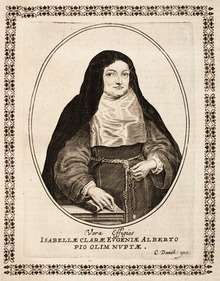Isabella Clara Eugenia
| Isabella Clara Eugenia | |||||||||||||||||||||
|---|---|---|---|---|---|---|---|---|---|---|---|---|---|---|---|---|---|---|---|---|---|
 Portrait by Frans Pourbus the Younger | |||||||||||||||||||||
| |||||||||||||||||||||
| Reign | 6 May 1598 – 13 July 1621 | ||||||||||||||||||||
| Predecessor | Philip II | ||||||||||||||||||||
| Successor | Philip IV | ||||||||||||||||||||
| Co-monarch | Albert | ||||||||||||||||||||
| Born |
12 August 1566 Palacio de Valsaín, Segovia, Spain | ||||||||||||||||||||
| Died |
1 December 1633 (aged 67) Brussels, Brabant | ||||||||||||||||||||
| Burial | Cathedral of St. Michael and St. Gudula | ||||||||||||||||||||
| Spouse | Albert VII, Archduke of Austria | ||||||||||||||||||||
| House | Habsburg | ||||||||||||||||||||
| Father | Philip II of Spain | ||||||||||||||||||||
| Mother | Elisabeth of Valois | ||||||||||||||||||||
| Religion | Catholic Church | ||||||||||||||||||||
Isabella Clara Eugenia (Spanish: Isabel Clara Eugenia; 12 August 1566 – 1 December 1633) was sovereign of the Spanish Netherlands in the Low Countries and the north of modern France, together with her husband Albert VII, Archduke of Austria. In some sources, she is referred to as Clara Isabella Eugenia. By birth, she was an infanta of Spain and Portugal.
Biography
Youth and family

Isabella Clara Eugenia of Austria was born in the Palacio del bosque de Valsaín,[1] Segovia on 12 August 1566, daughter of Philip II of Spain and his third wife Elisabeth of Valois.
Her father, Philip II, was reportedly overjoyed at her birth and declared himself to be happier on the occasion than he would have been at the birth of a son. Philip already had a male heir, Carlos, Prince of Asturias, the child of his first marriage to Maria Manuela, Princess of Portugal; however, father and son had never developed a close rapport and frequently lived in conflict with one another.
Isabella's mother had originally been betrothed to Don Carlos, but political complications unexpectedly necessitated her marriage to Philip instead. Despite the significant age difference between them, Philip was very attached to Elisabeth, staying close by her side even when she was ill with smallpox. Elisabeth's first pregnancy in 1564 ended in a miscarriage of twin daughters. She later gave birth to Isabella Clara Eugenia on 12 August 1566, and then to Isabella's younger sister Catherine Michelle 10 October 1567. Elisabeth miscarried a daughter in 1568 and died the same day.
Isabella grew up with her sister, beloved by her father and her stepmother Anna of Austria, Philip's fourth wife. Philip ultimately fathered five children by Anna, all of whom died in early childhood except his heir, Philip III. While Philip II is frequently characterized as having been cold and unaffectionate towards his offspring, there exist numerous letters addressed from him to his daughters which contain evidence of a deep attachment between them, each letter lovingly signed "Your good father".
Isabella was also the only person whom Philip permitted to help him with his work, sorting his papers and translating Italian documents into the Spanish language for him. Isabella remained close to her father until his death on 13 September 1598, and served as his primary caretaker during the last three years of his life, when he was plagued by gout and frequent illness.
Marriage

Since 1568, at the age of two, Isabella Clara Eugenia was promised to marry her cousin Rudolf II, Holy Roman Emperor (18 July 1552 – 20 January 1612), son of Emperor Maximilian II and her aunt Maria. Isabella Clara Eugenia, however, had to wait for more than 20 years before the eccentric Rudolf declared that he had no intention of marrying anybody.
After her uncle, Henry III of France, was assassinated by the fanatical young monk Jacques Clément on 2 August 1589, Philip II claimed the French crown on behalf of Isabella Clara Eugenia despite France's Salic law, which forbade cognatic succession. At any rate, Isabella Clara Eugenia's mother had ceded any claim to the French crown with her marriage to Philip II. However the Parlement de Paris, in power of the Catholic party, gave verdict that Isabella Clara Eugenia was "the legitimate sovereign" of France. The Huguenot leader, Henry III of Navarre, the rightful King of France by traditional French inheritance laws, ultimately made good his claim to the throne, converted to Catholicism and was crowned in 1594.
Her father decided to cede the Spanish Netherlands to her on condition that she marry her cousin, Albert VII, Archduke of Austria. They were to reign over the Netherlands jointly as duke/count and duchess/countess. They were to be succeeded by their descendants according to the male-preference cognatic primogeniture but should a female succeed, she was required to marry the King of Spain or the person chosen by the King of Spain. It was also stipulated that, should they have no children, the Netherlands would revert to the King of Spain upon the death of either spouse.
On 18 April 1599, being 33 years old, she married Albert, the younger brother of her former fiancé Emperor Rudolf II. Albert was the joint sovereign of the Seventeen Provinces and the former viceroy of Portugal. As Albert also was the Archbishop of Toledo, he had to be released from his religious commitments by Pope Clement VIII before the wedding could take place. Shortly before Philip II died on 13 September 1598, he resigned the thrones of the Netherlands in favor of Isabella and her fiancé.

Obv: Portraits of Albert and Isabella.
Rev: Eagle holding balance, date 1612.
Spanish Netherlands

Beginning in 1601, the couple ruled the Spanish Netherlands together, and after Albert's death Isabella was appointed Governor of the Netherlands on behalf of the King of Spain. A false anecdote links Isabella, the siege of Ostend, and the horse coat colour isabelline. The reign of Albert and Isabella is considered the Golden Age of the Spanish Netherlands.
The reign of the Archduke Albert of Austria and Archduchess Isabella Clara Eugenia is a key period in the history of the Spanish Netherlands. After four decades of war, it brought a period of much-needed peace and stability to the economy of the Southern Netherlands. In addition to economic prosperity, the actions of the two rulers stimulated the growth of a separate South Netherlandish identity. The two rulers consolidated the authority of the House of Habsburg over the territory of the Southern Netherlands and largely succeeded in reconciling previous anti-Spanish sentiments.
When it became clear that independence would not be possible, Albert and Isabella's goal became the reincorporation of the Southern Provinces into the Spanish monarchy. In pursuit of that goal and to get their political agenda to all Flemish social classes, Albert and Isabella used the most diverse media. The visual arts, with the baroque popularized in the wake of the Counter-Reformation, was the perfect tool. Thus Isabella and her husband stimulated the growth of this artistic movement, which resulted in the creation of the Flemish Baroque painting.

Their patronage of such artists as Peter Paul Rubens, Pieter Brueghel the Younger, Wenceslas Cobergher, the De Nole family, the Van Veens and many others were the beginning of a Golden Age in the Southern Netherlands. This, coupled with the political configuration of the period, made the Archdukes' Court at Brussels one of the foremost political and artistic centers in Europe of that time. It became the testing ground for the Spanish Monarchy's European plans, a boiling pot full of people of all sorts: from artists and diplomats to defectors, spies and penitent traitors, from Spanish confessors, Italian counselors, Burgundian functionaries, English musicians, German bodyguards to the Belgian Nobles. The Treaty of London and the Twelve Years' Truce were brought about thanks to the active involvement of the Archdukes in the negotiations. Brussels became a vital link in the chain of Habsburg Courts and the diplomatic conduits between Madrid, Vienna, Paris, London, Lisbon, Graz, Innsbruck, Prague and The Hague could be said to run through Brussels.
When Albert died in 1621, Isabella joined the Secular Franciscan Order and was appointed the Governor of the Netherlands on behalf of the King of Spain. She was succeeded as Governor by Cardinal-Infante Ferdinand of Austria, the third son of her half-brother Philip III of Spain in 1633.
Descalzas
She was of great importance of the Royal Convent of the Descalzas. She lived there as nun, with her aunt Empress Maria and gifted major artworks to the convent. Amongst others a famous serie of brussels tapestries. This famous cycle was designed by Rubens and depicts Isabella as patron Saint Clara of assisi with Monstrance.[2]
Ancestry
| Ancestors of Isabella Clara Eugenia | ||||||||||||||||||||||||||||||||||||||||||||||||||||||||||||||||||||||||||||||||||||||||||||||||||||||||||||||||||||||||||||||||||||||||||||||||||||||||||||||||||||||||||||||||||||||||||||||||||||||||||||||||||||||||||||||||||||||||||||||||||||||||||||||||||||||||||||||||||||||||||||||||||||||||||||||||||||||||||||||||||||||||||||||||||||||||||||||||||||||||||||||||||||||||||||||||||||||||||||||||||||||||||||||||||||||||||||||||||||||||||||||||||||||||||||||||||||||||||||||||||||||||||||||||||||||||||||||||||
|---|---|---|---|---|---|---|---|---|---|---|---|---|---|---|---|---|---|---|---|---|---|---|---|---|---|---|---|---|---|---|---|---|---|---|---|---|---|---|---|---|---|---|---|---|---|---|---|---|---|---|---|---|---|---|---|---|---|---|---|---|---|---|---|---|---|---|---|---|---|---|---|---|---|---|---|---|---|---|---|---|---|---|---|---|---|---|---|---|---|---|---|---|---|---|---|---|---|---|---|---|---|---|---|---|---|---|---|---|---|---|---|---|---|---|---|---|---|---|---|---|---|---|---|---|---|---|---|---|---|---|---|---|---|---|---|---|---|---|---|---|---|---|---|---|---|---|---|---|---|---|---|---|---|---|---|---|---|---|---|---|---|---|---|---|---|---|---|---|---|---|---|---|---|---|---|---|---|---|---|---|---|---|---|---|---|---|---|---|---|---|---|---|---|---|---|---|---|---|---|---|---|---|---|---|---|---|---|---|---|---|---|---|---|---|---|---|---|---|---|---|---|---|---|---|---|---|---|---|---|---|---|---|---|---|---|---|---|---|---|---|---|---|---|---|---|---|---|---|---|---|---|---|---|---|---|---|---|---|---|---|---|---|---|---|---|---|---|---|---|---|---|---|---|---|---|---|---|---|---|---|---|---|---|---|---|---|---|---|---|---|---|---|---|---|---|---|---|---|---|---|---|---|---|---|---|---|---|---|---|---|---|---|---|---|---|---|---|---|---|---|---|---|---|---|---|---|---|---|---|---|---|---|---|---|---|---|---|---|---|---|---|---|---|---|---|---|---|---|---|---|---|---|---|---|---|---|---|---|---|---|---|---|---|---|---|---|---|---|---|---|---|---|---|---|---|---|---|---|---|---|---|---|---|---|---|---|---|---|---|---|---|---|---|---|---|---|---|---|---|---|---|---|---|---|---|---|---|---|---|---|---|---|---|---|---|---|---|---|---|---|---|---|---|---|---|---|---|---|---|---|---|---|---|---|---|---|---|---|---|---|---|---|---|---|---|---|---|---|---|---|---|---|---|---|---|---|---|---|---|---|---|---|---|---|---|---|---|---|---|---|---|---|---|---|---|---|---|---|---|---|---|---|---|---|---|---|---|---|---|---|---|---|---|---|---|---|---|---|---|---|---|---|---|---|---|---|---|---|---|---|---|---|---|---|
| ||||||||||||||||||||||||||||||||||||||||||||||||||||||||||||||||||||||||||||||||||||||||||||||||||||||||||||||||||||||||||||||||||||||||||||||||||||||||||||||||||||||||||||||||||||||||||||||||||||||||||||||||||||||||||||||||||||||||||||||||||||||||||||||||||||||||||||||||||||||||||||||||||||||||||||||||||||||||||||||||||||||||||||||||||||||||||||||||||||||||||||||||||||||||||||||||||||||||||||||||||||||||||||||||||||||||||||||||||||||||||||||||||||||||||||||||||||||||||||||||||||||||||||||||||||||||||||||||||
Heraldry
| Heraldry of Isabella Clara Eugenia of Spain |
|---|
.svg.png) Coat of Arms as Infanta of Spain  Coat of Arms as sovereign of the Habsburg Netherlands |
Isabella in popular culture
- In the 2007 film Elizabeth: The Golden Age, Isabella appeared in a minor role at the side of her father, Philip II of Spain, at the time of the attempted invasion of England by the Spanish Armada in 1588. The movie portrays Isabella as Philip's choice to replace Elizabeth on the throne of England. She was portrayed by actress Aimee King as a young girl rather than as the correct age of nineteen years.
- Infanta Isabella is a minor character in the alternate history 1632 series, notably in the novel, 1634: The Bavarian Crisis. (She lives several years longer than in actual history.)
- In the 2002 alternate history novel Ruled Britannia by Harry Turtledove, where the Armada has been successful, Isabella has been made Queen of England while the deposed Elizabeth I is imprisoned in the Tower of London.
References
- ↑ http://arterural.com/noticias/la-infanta-isabel-clara-eugenia-cuando-llego-la-casa-thiar-julia/
- ↑ http://revistaseug.ugr.es/index.php/cnova/article/view/2562
- Cordula Van Wyhe (ed.), Isabel Clara Eugenia: Female Sovereignty in the Courts of Madrid and Brussels (Madrid and London, 2011).
- Werner Thomas and Luc Duerloo (eds.), Albert & Isabella, 1598-1621: Essays (Turnhout, 1998).
- Marie de Villermont, L'Infante Isabelle, Gouvernante des Pays-Bas (Paris, 1912).
External links
| Wikimedia Commons has media related to Infanta Isabella Clara Eugenia of Spain. |
| Isabella Clara Eugenia Born: 12 August 1566 Died: 1 December 1633 | ||
| Regnal titles | ||
|---|---|---|
| Preceded by Philip II of Spain |
Duchess of Brabant, Limburg, Lothier and Luxembourg; Margravine of Namur; Countess Palatine of Burgundy; Countess of Artois, Flanders, Charolais and Hainaut 6 May 1598 – 13 July 1621 with Albert (6 May 1598 – 13 July 1621) |
Succeeded by Philip IV of Spain |
| Government offices | ||
| Vacant Title last held by Archduke Albert of Austria |
Governor of the Spanish Netherlands 1621–1633 |
Succeeded by Cardinal-Infante Ferdinand |


